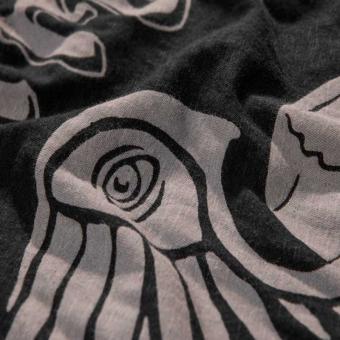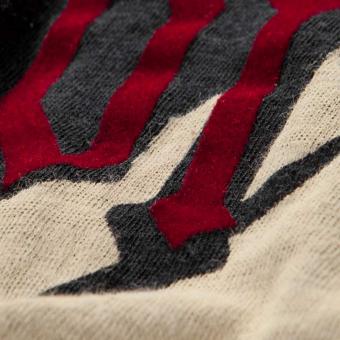Cotton Slub Single Jersey
Cotton Slub Single Jersey is the term for a light, fine-knit-like cotton fabric from Slub Yarn, which is characterised by a pleasantly soft fabric structure with a surface reminiscent of linen. As a ringspun effect yarn with irregular elongated thickenings, slub yarn made of pure cotton is categorised as a high-quality fine yarn as only raw cotton with medium to long high-quality staple fibres can be used for its production. The cotton fibres are thoroughly cleaned by repeated combing and are processed in a plurality of working steps to form a roving which is subsequently spun in a ring spinning machine into a fine denier yarn with the familiar look of slub cotton. Single jersey made of cotton slub yarn is airy, slightly stretchy and sometimes even slightly translucent due to the irregularity of the yarn.
Jersey is produced in different materials and fabric weights and is available in pure cotton, cotton blend or synthetic fibres. A small proportion of elastane is often added to the respective yarns in order to increase the elasticity and dimensional stability of the fabrics. The importance of fabrics is determined not only by the type of yarn, spinning technique and finishing processes but also by the weight of the fabric - in technical language, which is given in grammes per square metre of fabric and for pure cotton T-shirts between 120 g / 200 g / m².
In the textile sector, jersey is preferably used for the manufacture of lightweight sweaters, dresses, shirts, underwear and T-shirts so feeling comfortable as well as looking stylish is of the utmost importance. Depending on the material used, however, jersey materials can exhibit marked differences in quality, which can have a significant influence on comfort levels, especially when the garments are worn close to the body.
Single jersey made of pure cotton yarns is characterised by high air permeability and enormous absorbency while fabrics made of artificial fibres are impermeable to air and promote perspiration, but can absorb only a very small amount of body moisture. Due to this lack of 'breathability', synthetic material is characterised by a moist and warm climate, which considerably reduces the wearing comfort of the fabric by a "clammy" feeling on the skin and is also very unpleasant for hygienic reasons. Pure cotton fabrics can absorb up to 20 percent of their own weight of water or perspiration, and at the same time promote the evaporation of sweat by their high air permeability. The moisture in synthetic fabrics, on the other hand, remains on the skin and creates ideal breeding grounds for skin bacteria, especially at the sweating points under the fabric. The fresh, fundamentally odourless sweat and the skin fat secreted by the sebaceous glands is broken down by the bacteria into the organic components by an enzyme on the surface of the skin. During this decomposition process, an individual but usually very unpleasant smell occurs in a relatively short period of time. This process happens much faster when wearing garments made of artificial fibres because of the lack of air permeability, and also because of the way the sweat intensely adheres to the fabric.
Single jersey made of cotton slub yarn benefits from the excellent properties of this natural fibre, which is particularly popular in the textile sector. It is very breathable, absorbent, hypoallergenic and extremely durable despite the lightness of the fabric. Cotton slub single jersey is finished by pre-shrinking - also called sanforizing. Before cutting, the fabric is placed in a shrinking machine and naturally treated with steam and pressure so that clothes made from the fabric will not shrink in subsequent wash cycles, or lose their colour and shape.
DYSTROY TOPS ARE ONLY MADE FROM HIGH-QUALITY SINGLE JERSEY FABRIC 100% COTTON SLUB WITH A FABRIC WEIGHT OF 150g/ m².
Discharge Druck
Discharge printing is a complex screen printing process, also known as extract printing, and is only suitable for coloured textiles of pure cotton or fabrics with at least 80 percent cotton content. As synthetic fabrics can not be decolourised uniformly, discharge printing can not be used for textiles made of artificial fibres.
DYSTROY SHIRTS ARE ONLY MADE FROM PURE COTTON JERSEY AND PRINTED WITH DISCHARGE SCREEN PROCEDURES.
In the first stage, a bleaching ink is applied which decolourises the coloured cotton fabric in the printing range, returning it to the natural colour of the cotton. To activate the bleaching process and to prevent "bleeding" at the edges of the print design, the printed fabric must be dried in a tunnel dryer for at least 2-3 minutes at an average temperature of 140 - 170 ° C. Subsequently, the fabric can be printed with Discharge ink in a further printing process - with a water-soluble textile paint on acrylate, which is mixed with colour pigments for coloured printing designs.
After application of the Discharge colour, the textile is again dried at a temperature of between 140 - 170 ° C in order to fix the printing ink in the fabric by heat. To remove any colour residues left after the discharge printing, the fabric is washed in a final step at 30 ° C - 40 ° C. before the goods are released to the market.
Only environmentally friendly, water-soluble paints without chemical softeners are used for the Discharge screen printing, which dyes the previously decolourised fabric in the printing area without sealing the fibres with the ink. As a result, a particularly light, pleasantly soft print with a high wash-resistance is formed in which the ink is anchored in the fabric and is not felt as a raised, stiff surface even in fine jersey fabrics, and does not affect the natural fall of the textile. Discharge printing creates a light beige colour, rather than a pure white in the printing area of the fabric. This means that coloured designs in Discharge print are more matte than brilliant and have a convincingly fashionable vintage look.
Care instructions: Textiles with Discharge print designs should only be washed at cool temperatures up to 30 ° C and should not be tumble dried.

FLOCK PRINTING
In the case of flock printing, there is a distinction between the more complicated direct method of electrostatic flocking and printing with flocked film, which is cut out as a finished design and glued to the fabric with high heat and strong pressure. As flock film is relatively thick and has only a low elasticity, the prints look acceptable, but feel very unpleasant when worn, especially in the case of larger designs on lightweight fabrics due to the unyielding film. In addition, the durability of flock film designs is significantly less than direct flock printing, since the flock starts to peel off after several washes or features irreversible wrinkles on the design so that it often looks worn out after a relatively short time.
DYSTROY SHIRTS ARE EXCLUSIVELY PRINTED IN THE HIGH-QUALITY DIRECT FLOCK PRINTING METHOD.
Flock is the name of textile fibres selected from cotton yarn, viscose or synthetic fabrics that are mechanically cut or woven into the tiniest particles and then coated in a water-based solution containing various salts and tanning agents, whereby they do not stick together in their dry state and have the necessary conductivity for electrostatic flocking.
The direct flock method is a special type of screen printing in which a water-soluble adhesive is applied to the fabric instead of colour in the form of the design, and the flock is then applied to the moist adhesive by electrostatically charging the fibre particles to the wet glue. The electrical voltage field is generated by a high voltage generator, to the positive and negative poles of which a metal plate is connected underneath the material provided with adhesive, and another is connected to the interior of the flocculation tank. The flocculation tank is provided with a fine-mesh screen at the lower opening and is positioned directly above the fabric or textile.
When the generator is switched on, the metal plate in the container and the wet flock adhesive builds shoot the charged flock fibres through the screen directly into the adhesive on the textile. The metal plate in the flocking container and the moist glue build up the charged flock fibres through the screen directly into the glue on the textile. As the electric field lines between positive and negative charges are always perpendicular to the conductor surface, the electrostatically charged flock fibres are also oriented perpendicularly in the moist adhesive mass and form a uniformly slightly raised surface, which is characterised by a velvety structure so even large designs have a pleasantly soft feel on the fabric. For curing the adhesive and simultaneously fixing the flock print, the printed textile is dried in a circulating air oven and then mechanically cleaned of excess flock particles.
Flock printing is regarded as one of the best quality printing processes in the textile industry and is preferably used for the finishing of logos, lettering and larger designs without colour gradients. Flock printing is not suitable for the representation of filigree designs with thin lines. The strength of the flock printing is variable but should be chosen in an appropriate ratio to the weight of the fabric, i.e. a sweatshirt required a thicker flock print than a light shirt fabric. The electrostatic flocking in the direct flock process results in an optimal print result in the form of colour-intensive and hard-wearing designs, which are distinguished by a high wash resistance with a pleasantly soft surface and a great looking print.

 Did you forget your password?
Did you forget your password?


























